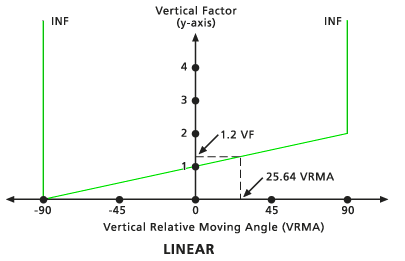Mit der Spatial Analyst-Lizenz verfügbar.
Zusammenfassung
Defines the relationship between the vertical cost factor and the vertical relative moving angle through a linear function.
Abbildung

Auswertung
The VfLinear object is used in the Spatial Analyst tools Path Distance, Path Distance Allocation, and Path Distance Back Link.
The vertical factor (VF) object defines the relationship between the vertical cost factor and the vertical relative moving angle (VRMA).
VF defines the vertical difficulty encountered in moving from one cell to the next.
VRMA identifies the slope angle between the FROM or processing cell and the TO cell.
The VFs are determined by a straight line in the VRMA-VF coordinate system. The line intercepts the y-axis, equitable to the VF factor, at the value associated with the zeroFactor. The slope of the line can be specified using the slope argument.
Syntax
VfLinear ({zeroFactor}, {lowCutAngle}, {highCutAngle}, {slope})| Parameter | Erläuterung | Datentyp |
zeroFactor | The zeroFactor will be used to position the y-intercept of the linear function. (Der Standardwert ist 1.0) | Double |
lowCutAngle | The VRMA degree defining the lower threshold, below which (less than) the VFs are set to infinity. (Der Standardwert ist -90.0) | Double |
highCutAngle | The VRMA degree defining the upper threshold, beyond which (larger than) the VFs are set to infinity. (Der Standardwert ist 90.0) | Double |
slope | Identifies the slope of the straight line in the VRMA-VF coordinate system. Slope is specified as the rise/run. For example, a 30-degree slope is 1/30, specified as 0.03333 (rise/run: 1 VF on the y axis / 30 degrees on the x axis); a 90-degree slope as 0.011111. (Der Standardwert ist 0.011111) | Double |
Eigenschaften
| Eigenschaft | Erläuterung | Datentyp |
| zeroFactor (Lesen und schreiben) | The zeroFactor is used to position the y-intercept for the vertical factor class. | Double |
| lowCutAngle (Lesen und schreiben) | The VRMA degree defining the lower threshold, below which (less than) the VFs are set to infinity. | Double |
| highCutAngle (Lesen und schreiben) | The VRMA degree defining the upper threshold, beyond which (larger than) the VFs are set to infinity. | Double |
| slope (Lesen und schreiben) | Identifies the slope of the straight line in the VRMA-VF coordinate system. Slope is specified as the rise over the run. For example, a 30-degree slope is 1/30, specified as 0.03333 (rise/run: 1 VF on the y axis / 30 degrees on the x axis); a 90-degree slope as 0.011111. | Double |
Codebeispiel
VfLinear example 1 (Python window)
Demonstrates how to create a VfLinear class and use it in the PathDistance tool within the Python window.
import arcpy
from arcpy import env
from arcpy.sa import *
env.workspace = "C:/sapyexamples/data"
myVerticalFactor = VfLinear(1.0, -90.0, 90.0, 0.01111)
outPathDist = PathDistance("source.shp", "costraster", "", "", "", "",
myVerticalFactor)
outPathDist.save("C:/sapyexamples/output/pastdistvfl")
VfLinear example 2 (stand-alone script)
Performs a PathDistance analysis using the VfLinear class.
# Name: VfLinear_Ex_02.py
# Description: Uses the VfLinear object to execute the PathDistance tool
# Requirements: Spatial Analyst Extension
# Import system modules
import arcpy
from arcpy import env
from arcpy.sa import *
# Set environment settings
env.workspace = "C:/sapyexamples/data"
# Set local variables
inSourceData = "source.shp"
inCostRaster = "costraster"
# Create the VfLinear Object
zeroFactor = 1.0
lowCutAngle = -90
highCutAngle = 90
slope = 0.01111
myVerticalFactor = VfLinear(zeroFactor, lowCutAngle, highCutAngle, slope)
# Check out the ArcGIS Spatial Analyst extension license
arcpy.CheckOutExtension("Spatial")
# Execute PathDistance
outPathDist = PathDistance(inSourceData, inCostRaster, "", "", "", "",
myVerticalFactor)
# Save the output
outPathDist.save("C:/sapyexamples/output/pastdistvfl2")